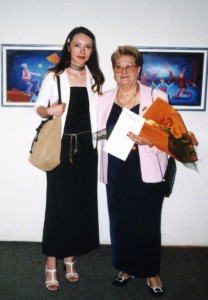Her role model was her father
 Banat village Kovačica became worldwide famous for its numerous painters. The members of this ethnically isolated and closed national society carefully kept and nurtured all the moral, social and historical characteristics of their forefathers. They kept all the peculiar things that distinguished them from the others, passing it down from generation to generation.
Banat village Kovačica became worldwide famous for its numerous painters. The members of this ethnically isolated and closed national society carefully kept and nurtured all the moral, social and historical characteristics of their forefathers. They kept all the peculiar things that distinguished them from the others, passing it down from generation to generation.
Among many painters who lived (or still live) in Kovačica, Jan Knjazovic has an honorable place. He appeared on this art scene in 1951, together with Martin Jonaš. Both of them – in their own way, secured originality and singularity of their work by reducing the elements of folklore to the elements of color. But Jan Knjazovic’s premature death prevented him to express his full creative energy.
He named his only daughter Ana, and she was the one and only person that he loved more than painting. Therefore he loved spending time with her, giving her paper and colorful pencils. There is something primeval, something more important than anything else in us – a legacy that no one is aware of, but still it is genetically passed on to the younger generations and occupy them. And that is why the little blond girl with angel eyes was always sitting next to her father, painting. She was drawn by some distant magical dreams made under the skilled brush strokes of her father. She was in love with that world luring her from the paintings, and her favorite smells were paints and turpentine.
Knjazovic choose those typical themes of his surrounding and climate, in which he was born, and where he lived. He painted his fellow peasants in the field in each season, he painted them on the market, on wedding or while dancing; he painted their troubles, sadness, joy… And still, many things distinguished him from the other painters in Kovačica. The strength and recognition of his artistic expression is in the specific presentation of those themes. He used colors, light and shapes lightly, easily and without excessive details he created unusual, but compiling composition. By his recognizable coloring (dark purple, dark blue with orange accents, pink and yellow), stylization and shapes (houses, animals, flowers, people), with a frequent dose of a light humor Jan Knjazovic has built an authentic artistry within Kovačica art circle. Ana grew up and the roads were leading her higher and further. Painting was not her only concern now, although she often returned to it, each time better and safer.
After her father’s death and some personal breakdowns, as already mature person with the certain view of the world, she took the paintbrush in her hand, and while returning into the childhood and warm memories of the great painter, a wonderful father and a great man, she was afraid. And she wondered: Can I succeed? Will I not embarrass my father? And suddenly her responsibility doubled: What will my fathers’ audience and critics say? What would my father say if he could see it? But all that got answered very soon. Her paintings found their way to the audience and established the communication right away. It was heard: Already seen, but still not the same thing. Sensibility and poetry of heart which goes into the brush makes Ana’s paintings a bit more lyrical, with darker tones and vivid colors of the figures she is achieving greater strength and volume, it is more dynamic. The figures are less static. The public was at first reserved, slowly getting used to her paintings, and then accepted it unconditionally. Ana was finally happy. She felt her father’s dear look somewhere near here, his warm blue eyes were smiling, and she could almost feel his breath. And she knew it. She succeeded!
So many times she observed that simplified form, emphasizing or highlighting something. And she perceived it with understanding; it was impressed in her mind. In the childhood man remembers things and do not forget. Today, she often finds herself unconsciously reaching for the same colors her father used. Ana lives by these reminiscences, and she knows that as long as she paints, her father will live. She feels it as an incarnation of a great man, who was her father and gave her the first painting lessons straight from his heart.
When I saw her paintings for the first time, I said: Welcome, Ana! She looked at me bashfully and said: Are you serious? Many people say that I’m just like my father. I laughed: I guess you look like him? That’s alright. Many of them are like Bosch, Brueghel,Večenaj, Generalić and so on, and I am not sure that they are even related.
History teaches us that each artistic projection impose by its meaning and the material existence. And the meaning depends on heterogeneous factors.
Koviljka Smiljković



